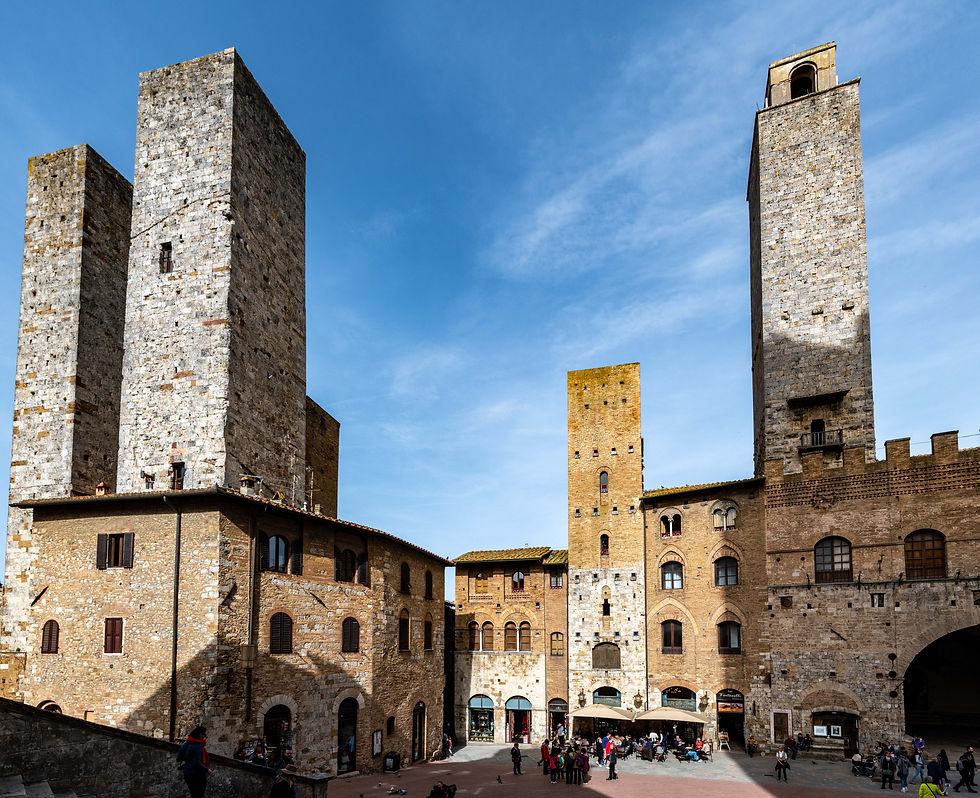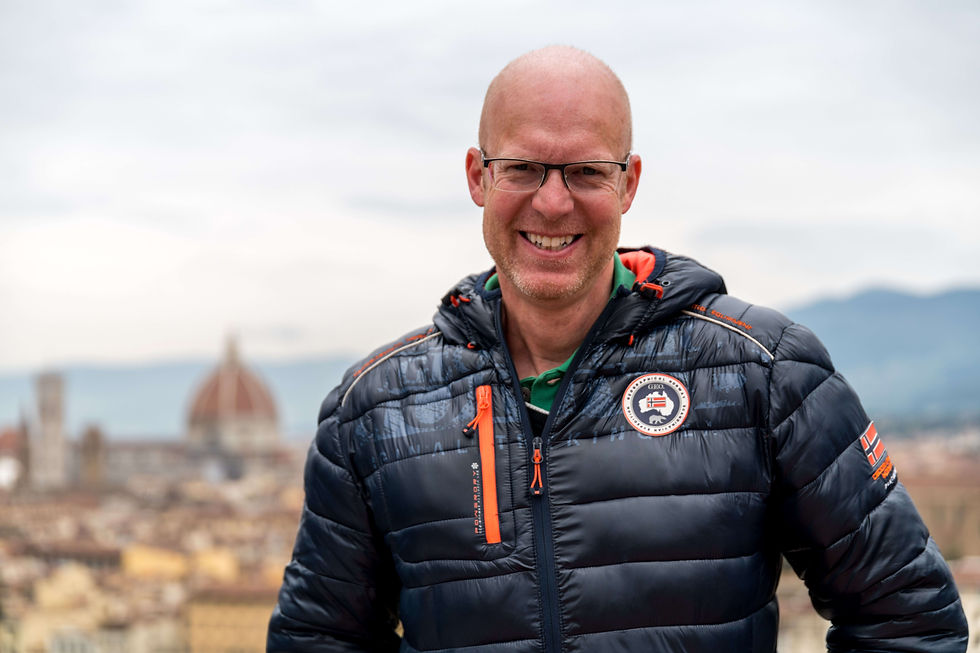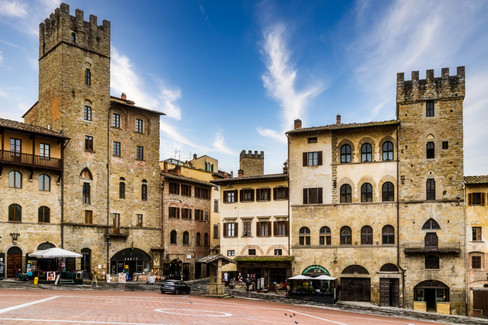Tuscany
- Aaron & Clare

- 8. Okt. 2021
- 7 Min. Lesezeit
Beautiful landscapes, ancient history and gastronomic delights!
Tuscany is a world-famous region of Italy with so much history and some amazing highlights: Pisa, Florence and Siena are real treasures and on top of this are the rolling hills, fabulous wine areas and great food.

In 2018, we’d booked a two-week trip that we had originally intended to spend with our beloved Labrador Mungo, but too sadly, he passed away a couple of weeks before. We left with heavy and broken hearts, the pain of the loss of him, his purest love and light, our best friend and angel, was almost too much to bear, especially for Clare. Despite having written this blog soon after the trip, it’s taken this time to actually publish it.
Arezzo & Cortona
Before the trip Aaron did some extensive research for the best photo locations.
Our choice of accommodation had 2 main factors – a strategic location from where we could easily access all the places we wanted to visit and a pool for Mungo and us.
We found a beautiful house on Airbnb located in Monte San Savino in the province of Arezzo which was advertised as ‘wonderful villa in Tuscany' and it turned out to be exactly that - we can truly recommend this gorgeous place.

Close to the Appenine mountains we visited two interesting cities: Arezzo, the fourth biggest city in Tuscany, after Florence, Livorno and Prato. The old city has a special vibe and the beautiful medieval Piazza Grande was a film location for the movie ‘La vita è bella – Life is beautiful.
Cortona is further south and a must visit. This little city lies on top of a hill and the popular old town has many narrow alleys with good restaurants, gelaterias and boutiques. We also found a very special shoe boutique on the main piazza where Clare couldn’t resist a bit of shopping in there… 😊.

Siena
Siena has a great atmosphere and we prefer it to Florence. Despite 5 million visitors a year, Siena is still an authentic city built more for Italians and not for tourists. The architectural highlights are the cathedral and the Palazzo Publico.

The Duomo is one of the most important Italian Gothic architectures and the black and white marble combination is unique for this region. There are many engravings and sculptures on the beautiful facades such as prophets, apostles, winged lions, horses and the famous Roman wolf that feeds children.

Entering the cathedral is very impressive. The floor, columns and cupola have all been constructed and created with so many details. And just the sheer size of it is mind-blowing.

It’s hard to believe that in 1339 there were plans to expand the cathedral. The idea was to build the biggest church in the world. On the picture below, on the left of the cathedral you can see the wall of one of three additional naves that were planned with an indication of a new facade called ‘Facciatone’.

You can actually go up to the Facciatone passing through the very interesting Museo dell’ Opera, where many of the cathedral’s original sculptures are exhibited. From the terrace, you’ll find one of the best view points of the city.

The center of Siena is set around the Piazza del Campo, one of the most renowned squares in Italy. Twice a year, there’s a horse-race called Palio di Siena around the Piazza, where the riders are dressed in colours representing their district of Siena.

The Palazzo Publico with the Torre del Mangia is a striking building. It was built around the same time as the Duomo to serve as the seat of the Republic of Siena. The height of the tower is the same as the cathedral in order to express that the state has equal amount of power as the church. There is a great angle up to the tower from the yard next to the ticket office.

The view from the top of the bell tower is amazing too. Here you have a brilliant view of the city plus the rolling hills of Tuscany in the distance. As a dining highlight, we went to have truffles for lunch at the beautiful restaurant called Tar-Tufo, which isn’t far from the Piazza.

San Gimignano
Our next stop was San Gimignano – ‘the town of fine towers’. This small medieval town is very well preserved and sits on a hill encircled by town-walls. This place with its dozen towers can best be photographed from a little way outside of town.

There are eight entrances to the old town, and there are many examples of Romanesque and Gothic architecture to be seen. After a lovely stroll through the town, we ended up enjoying the late afternoon sun with a drink and some snacks at one of the charming restaurants at the old stone wall with great views of the surrounding hills.

Florence
This is most likely the first name that you think of in Tuscany. And, you can really see and experience what a tourist hotspot Florence has become. When Aaron studied Italian in Florence for a few weeks in the 80’s he found the vibe to be truly amazing. Today, with 16 million overnight stays (2019) that original atmosphere is gone.

For your visit to Florence, our recommendation is, spend a couple of nights and make sure to get up early to enjoy the morning silence at the Piazza del Duomo, the Piazza della Signoria with the Palazzo Vecchio, and the Ponte Vecchio.
We parked on a hill at the Piazzale Michelangelo and found it to be one of the best places to get a good view of the city. The huge cathedral, palace, bridge, and the mountains in the background are clearly visible from this spot.

We then walked down to the centre and crossed the river at Ponte Santa Trinita. From here you have a great view to Ponte Vecchio.

Around lunch time we passed the famous statue of David from Michelangelo which is in front of the Palazzo Vecchio. From there we headed towards the Piazza del Duomo. We wanted to go up to the Giotto’s Bell Tower (Campanile di Giotto) to enjoy the view of the cathedral (duomo) but it was impossible without an advanced reservation. The same was true for the Duomo.

With all the crowds it was difficult to shoot any very interesting photos and we weren’t really in the mood for shopping so we decided to leave Florence a bit earlier than planned.
Wine areas
Our next trips were focussed on the famous wine areas of Tuscany: Chianti, Brunello and Vino Nobile di Montepulciano are world-famous wine brands. 20 years ago, we spent some beautiful days with friends near Radda-in-Chianti and therefore wanted to re-visit this place. It’s a very small town built in traditional Tuscan style. We had lunch at the restaurant La Botte di Bacco and it was once again superb.

Next was Montepulciano. Another old town that lies on top of a hill and there are some lovely viewpoints over the vineyards. We loved this small town with its good restaurants and wine bars, where we tasted some of the local wines and delicacies.

Landscapes
Tuscany is also famous for its beautiful landscapes and it takes some research to find the best photo locations. As a base we stayed at the hotel Casanova Srl in San Quirico. From here it’s a short walk to the village center with - guess what - more great restaurants 😊. One of the most famous views of the Tuscan landscapes is very close to the hotel: the Podere Belvedere.

A short drive from here towards Pienza is another interesting photo stop: The Chapel Vitalets. There is already a decent view of the chapel from the main road but to get a better one closer to it you’ll need to drive a short detour. To get this photo, Aaron changed his Tamron wide-angle lens to a tele lens. …and then he left the wide-angle lens on top of the car… a pretty expensive and stupid mistake that was…☹!

Typical and famous for Tuscan landscapes, are the Italian cypress trees that line some of the roads. A very beautiful tree formation is next to the road going from San Quirico towards Montalcino. There aren’t many places to park your car and at first try, we missed this place, that’s in the middle of nowhere.

Further south is La Foce near Chianciano Terme. We had to walk around a bit to find the place we were looking for: towards the east and the Riserva Naturale Lucciola Bella you can see the winding road towards the Agriturismo Podere Casanova. Aaron had to do a bit of climbing to get up on the wall for a good view.

Finally, another postcard perfect location – or nowadays, …instagram location – is the road leading towards the Agriturismo Baccoleno. Although once again, we missed the turn-off first time round but Google Maps helped us in the end.

Pisa and Livorno
On a different trip when we were travelling to the French island of Corsica, we took the opportunity to visit another Tuscan highlight: the world-famous Leaning Tower of Pisa. It is truly spectacular to see this tower next to the church. A very unique building!

Livorno is the third biggest city of Tuscany with a population of about 160’000 people. The port is the main reason to come here to get the ferries and we didn’t expect much. But walking along the promenade was an enjoyable experience.

Tuscany is truly a very special region to explore. The Italian descriptions ‘La Vita é Bella’ and ‘La Dolce Vita’ are a perfect fit for the experiences and moments you will enjoy here.

Our other published blogs of the series 'Our favourite places in Bella Italia' cover the following areas (with links):
Part 1: Milan - Milano
Part 2: Venezia
Part 3: Amalfi
Part 4: Puglia
Part 5: Cinque Terre
Part 6: Langhe - Wine Area of Piemonte
"One crowded hour of glorious life is worth an age without a name"
(The Call - Thomas Osbert Morsdaunt, 1730-1809)
Travel blog and travel guide by Aaron Matzinger & Clare Walker
© Aaron Matzinger & Clare Walker











Kommentare